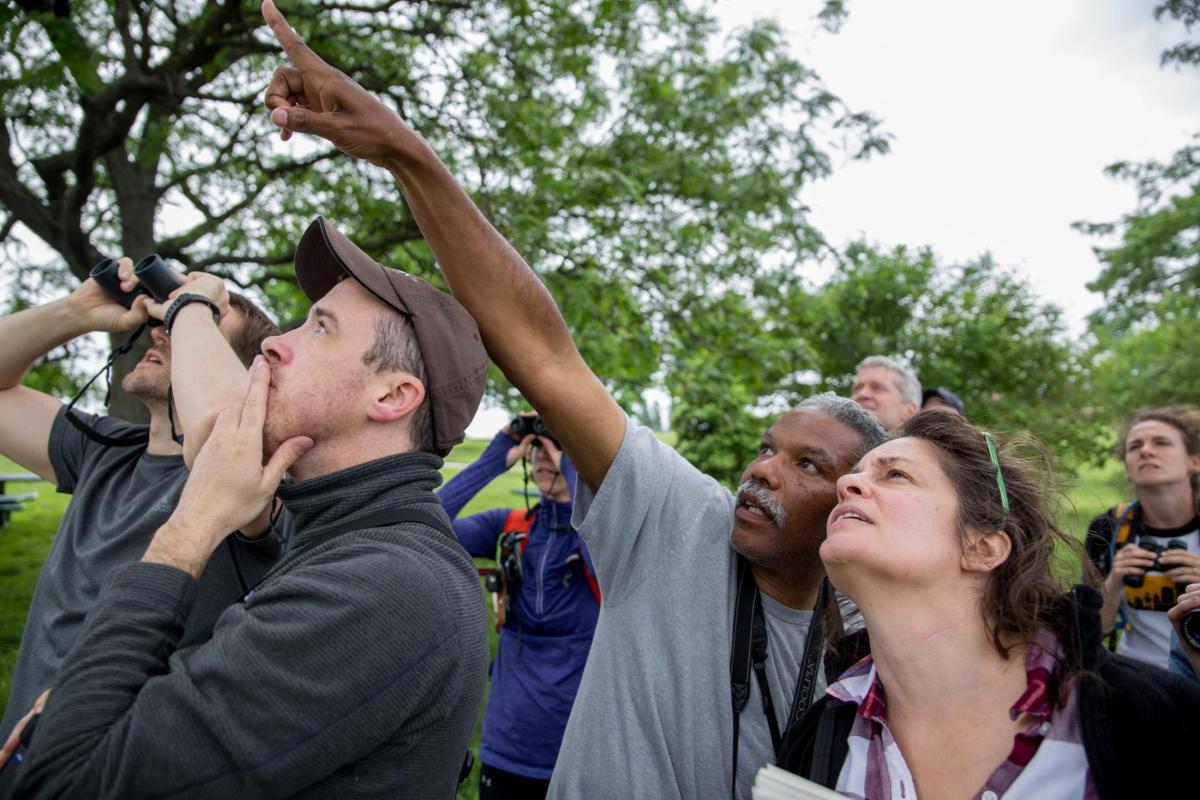
Every spring, the Patterson Park Audubon Center—a branch of the National Audubon Society that seeks to connect city dwellers with nature and help preserve Baltimore’s bird habitats—hosts Baltimore Birding Weekend, which invites local orinthophiles to the city’s green spaces for bird-watching sessions.
From May 12-14, guided adventures by vehicle, water, and foot yielded a bird’s-eye view of Charm City’s roughly 300 winged species. Ticketed trips (the $30 price of admission acts as a fundraiser to support the efforts of the Audubon Center,) scheduled throughout the weekend included hikes throughout the Cox Creek and Swan Creek Wetlands in Curtis Bay; a photo excursion around the Stony Run in North Baltimore; and bird catching and banding with nonprofit Birds of Urban Baltimore at Patterson Park.
“One of the things that was important to me when creating this event was flipping the narrative of, ‘We have to leave the city to experience nature.’ No we don’t,” says Patterson Park Audubon Center director Susie Creamer. “We have a wonderful park system, as well as other small patches that create these oases for habitat and spaces for us to restore ourselves.”
Creamer looks at the now six-year-old tradition as a celebration of Charm City’s birding scene, and hopes all who are curious about local wildlife will get involved in Baltimore Birding Weekend.
“This is for everyone of every experience level,” she says. “You don’t have to be a super ‘nerdy birdy,’ which is what we lovingly call people who know a lot about birds. It’s a learning experience.”
In honor of the event, we round up some of the best Baltimore bird-spotting sites to check out, below.
Druid Hill Park: America’s third-oldest public park, this Northwest Baltimore wonder boasts 180-plus species, like the Yellow-Crowned Night Heron and our own Baltimore Oriole. “What’s great about Druid Hill Park from a bird-watching standpoint is that it has these large, mature trees in a grassy area,” Creamer says. “Logistically, being able to circle around the tree allows a birdwatcher to get a better look at something.” 2600 Madison Ave.
Fort McHenry: Roughly 250 bird species have passed through this Locust Point landmark. ”It is quite a birding hotspot,” says Creamer. “There are mature trees, there’s the waterfront aspect, and there are trails that allow you to go down into the wetland.” Look out for friends like the Spotted Sandpiper, Marsh Wren, Yellow Warbler, and Great Crested Flycatcher. 2400 E. Fort Ave.
Gwynns Falls/Leakin Park: Perhaps Baltimore’s largest park at 1,000-plus acres, the Gwynns Falls is the known home of 152 bird species so far. This month, keep an eye out for House Sparrows, Chimney Swifts, Northern Parulas, and Blue-Gray Gnatcatchers. 4500 Franklintown Road.
Herring Run Park: Renowned for its lush woodlands, this Northeast Baltimore Park is a bird-watcher’s haven. “Last year, we saw nesting Barred Owls there,” recalls Creamer. Don’t be surprised to see other bird pals like the Red-Shouldered Hawk and the Downy Woodpecker. 3800 Belair Road.
Middle Branch Park: Bordering the shores of the Patapsco River, this Cherry Hill greenspace is the best place to encounter birds like Mallards and Song Sparrows. But the main draw is the Bald Eagle. Nearby restoration site Masonville Cove has more than 70 acres of bird sanctuary, with buffers on some trails to separate nesting Bald Eagles from visitors. 3301 Waterview Ave.
Patterson Park: The park’s 40-plus resident birds include the Yellow-Bellied Sapsucker (try saying that one five times fast) and the Cooper’s Hawk. Other regulars this time of year include the Tufted Titmouse, Warbling Vireo, and Tree Swallow. Creamer says it’s also not uncommon to spot Orioles, whose nests hang low in woven clumps. 2601 E. Baltimore St.
Stony Run: The largely-wooded North Baltimore stream and trail has seen the likes of Black-Throated Green Warblers and Common Ravens. Throughout May, look for visitors including the Louisiana Waterthrush and Hooded Warbler. 599 Wyndhurst Ave.
Wyman Park: This green space near the Baltimore Museum of Art plays host to Prothonotary Warblers and Pileated Woodpeckers. 3000 N. Charles St.
